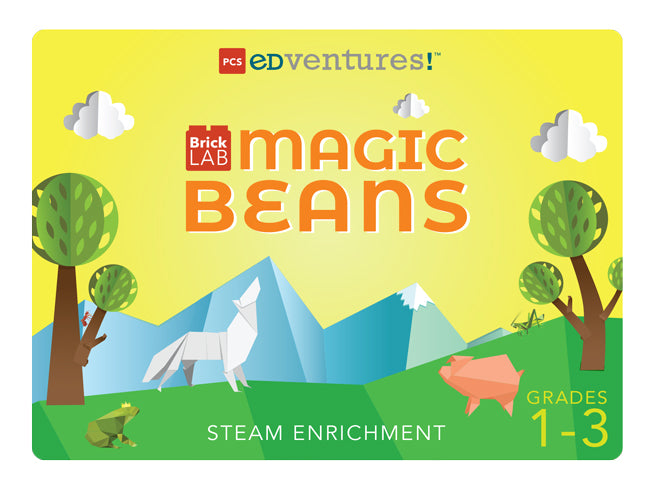
Stress Less with More STEM
Educators are professional jugglers, balancing everything from daily responsibilities to their mental health and that of their learners. It’s rewarding, but keeping everything in the air at once can be exhausting. Wouldn’t you love ready-to-go programs that have the work done for you? PCS Edventures has you covered! We provide one less thing for you to juggle, reducing stress by adding more STEM.
PCS Edventures’ all-inclusive programs let educators in and out of the traditional classroom setting spend more time facilitating and less time stressing!
Our turn-key programs allow you to become actively engaged in learning. Let’s explore two popular programs that make a big impact through their lighthearted, hands-on approach: BrickLAB Magic Beans for Grades 1-3 and BrickLAB Core for Grades 1-6.
These exciting programs engage learners through 12 interactive lessons that play on the power of interlocking bricks and design. Both programs can be used interchangeably to enhance learning in traditional and out-of-school settings. Whatever your instructional environment, such mindful, structured activities aid learners’ mental health while alleviating the pressures of teaching.
Spend Less Time Planning
Planning exhausts educators' already limited time. That’s why we’ve ensured that our programs include easy-to-follow instructor guides. Complete with background information, scripted suggestions and discussion questions, you’ll have everything you need to implement an exciting STEM lesson in a flash. What’s more, we provide the manipulatives and resources needed to engage learners.
Traditional Classroom Setting:
Educators in a traditional year-round setting benefit from the cross-curricular integration in STEM programs. It’s simple to meet the many standards across the school year.

For example, BrickLAB Magic Beans provides 12 days of lessons focusing on fairy tales, with exciting activities addressing NGSS and math standards that seamlessly intertwine. Learners collaborate to act out a fractured fairy tale, count and build with BrickLAB manipulatives, complete engineering challenges and think critically about a text when answering comprehension questions. It’s an exciting way to address multiple cross-curricular standards in every pre-planned lesson throughout the year!
Find more tips and resources for using our programs year-round in our blog post, A Year of STEM.
Out-of-School Learning Environment:
Working in an out-of-school setting within a shorter time frame? You can adapt our flexible programs to fit your specific needs.
In BrickLAB Core, educators can choose science, social studies, math and literacy activities that best meet their curriculum goals. Each subject is broken down into three interactive lessons that include cross-curricular standards, allowing educators to tackle various skills quickly and effectively.
No matter which lessons you choose, learners express their understanding through independent practice using ready-made resources. PCS Edventures provides sample build guides, worksheets and more to ensure necessary materials are all set. Just one less thing to worry about!
Build Meaningful Relationships with Learners
STEM offers learners the opportunity to make discoveries with their peers through hands-on activities. At the center of it all, an enthusiastic educator is connecting with each group, inspiring curiosity, encouraging risk-taking and fostering areas of strength.
Our ready-made STEM programs provide you the opportunity to become a facilitator in your classroom. You spend less time in front of students and more time actively participating with them, amid the excitement. Breathe a sigh of relief — we provide fun and memorable lessons so you can focus on building lasting relationships with your learners!
Traditional Classroom Setting:
Learners love connecting with their teachers through our cross-curricular STEM activities. In BrickLAB Magic Beans, group work allows you to quickly identify students’ areas of strength and areas that require assistance.
Each of the 12 lessons showcases individual interests: literacy, science, math, engineering, art... you name it! Readers thrive in their role when acting out a fractured fairy tale. Engineers shine as they work to count and build props using our signature Perfect Bricks. Writers relish responding creatively to writing prompts. The best part? This is done while connecting with learners one-on-one to inspire their strengths!
Now, as educators, you know that students may require extra support. Deciding how to support them can be stressful, but don’t worry! Our activities provide the opportunity to step away from lecturing and instead connecting with focused groups of learners. You can support them by decoding lines in their fairy tale role, using manipulatives to strengthen their understanding of mathematical concepts, or fine-tuning grammar while writing. BrickLAB Magic Beans is truly a way to build memorable relationships with your learners and enhance their educational experience in fun, creative ways!
Out-of-School Learning Environment:
Time sure does fly when you’re working in an out-of-school setting! Luckily, our engaging activities help build meaningful relationships with learners in a shortened timeframe. BrickLAB Core lessons encourage collaboration, critical thinking, and personal expression.

For example, in the lesson “Topographic Maps,” learners complete a challenge by analyzing maps. Educators circulate through groups, asking meaningful questions to understand learners’ thoughts. Studying maps and building with our colorful interlocking bricks allows you to model effective communication.
Finally, learners build a topographic map of their favorite place. This opens the door for discussions about personal interests and inspires learners to listen deeply to one another. You’ll be amazed at how quickly programs help develop your relationships with learners and foster connections among classmates.
Practice Mindfulness with Movement and Manipulatives
Manipulatives and movement keep learners’ bodies and minds active. As they tinker with bricks and move around the room, they’re often so absorbed in the activity that the day’s troubles fall by the wayside. It’s an excellent way to practice mindfulness. Best of all, when learners are relaxed, educators are less stressed, making it easier to direct their time and energy toward teaching core concepts.
Whenever possible, encourage your learners to participate in free builds. In other words, provide times when they can choose designs to build and explore outside of the structured lessons. Learners quickly discover how fun learning can be with our signature Perfect Bricks. Allowing their imaginations to shine through creative thinking and problem-solving will do wonders for their mental well-being and yours.
Traditional Classroom Setting:
Our programs are the ideal way to break up a long school day. Since STEM blends movement and mindfulness activities with academics, additional brain breaks that squander instructional time are unnecessary.
Take any lesson in BrickLAB Magic Beans, for example. Each begins with Folktale Theater, giving learners a chance to take to the stage and perform a hilarious fractured folktale play. They feature a variety of roles, big and small, ensuring that everyone can take part in the action. Following this stimulating performance, learners use interlocking bricks to craft a structure based on the play they’ve just read. Finally, they participate in exciting engineering challenges, lesson extensions and more.
This style of engaging, uninterrupted instruction provides ample opportunities for movement and mindfulness in a way rarely seen during a traditional lesson. In this way, learners alternate between active and more calming activities while meeting multiple reading comprehension, Habits of Mind, 21st Century Skills and Next Generation Science Standards (just to name a few). Such a balance helps you and your class sustain much-needed energy throughout lengthy school hours.
Want to give it a try? Check out our Fractured Folktale: Paul Bunyan freebie for an activity based on those found throughout BrickLAB Magic Beans.
Out-of-School Learning Environment:
In addition to providing the perfect blend of mindfulness and movement, incorporating more STEM into summer and after-school schedules makes learning more interactive and fun!
The best discoveries happen when learners are so immersed in a task that they barely realize they’re hard at work. That’s what makes BrickLAB Core so uniquely valuable.
For instance, while focusing on building a model community of bricks in BrickLAB Core Grade 1, learners discuss what makes a community continue to grow and what makes families want to stay. They then move around the room to examine how different groups organized their communities before everyone joins their models together to form one mega-brick town.

Learners are simply having fun building, moving and problem-solving along with others, while meeting core standards that require critical thinking. This targeted work helps support concepts taught in traditional classrooms, extending learning for all. It's a tremendous benefit for learners!
STEM Helps Alleviate Anxiety
How can STEM reduce anxiety in a learning environment? A recent study identified that inclusive, equitable and empowering environments help reduce college-level learners’ anxiety (Hsu & Goldsmith, 2021). Unsurprisingly, this is true in K-12 STEM settings as well.
Our programs promote the idea that failure is awesome. Anxiety often stems from a fear of failure. Thus, an inclusive and equitable learning environment where learners are comfortable making mistakes can reduce stress and anxiety (Cooper and Brownell, 2020; Downing et al., 2020).
As learners work, their brick creations may fall over or not turn out as they’d hoped. This teachable moment helps foster a growth mindset, reminding them that success does not always come from our first, second, or even third try. If their builds don’t turn out as expected, they are still discovering what not to do, which is awesome!
Traditional Classroom Setting:
Another way STEM can reduce anxiety for learners and educators is through intentional student groupings. Educators in a traditional setting benefit from working with the same group of learners year-round. This allows them to build strong bonds with one another. Over time, they become more comfortable working with peers they see throughout the school week. Use this to your advantage when forming groups.
BrickLAB Magic Beans offers several opportunities for grouping learners throughout a lesson. Some examples include:
- Random Grouping
- Student Choice/ Interest Based
- Academic Ability Level
- Skill or Strategy-Based

For example, when selecting readers to act out roles in a particular fractured fairy tale, read through the play as a whole class and assign roles randomly, or try asking learners to choose their groups based on who would like to play a particular role. Alternatively, group them using class reading comprehension data and meet with different levels to deliver targeted, differentiated instruction.
When educators group learners intentionally, they can provide the least stress-inducing environment for all. What matters most is knowing what will work best for your group of learners. As we know, that can change from day to day!
For more information, check out Student Grouping Strategies to Maximize Engagement.
Out-of-School Learning Environment:
Out-of-school environments often have the unique opportunity to make learning an adventure, without being tied to grades or evaluations. Outside the structure of a traditional classroom, learners may be more open to risk-taking, puzzling through challenges and sharing mistakes.
Now, how do we create this positive environment? Well, STEM programs such as BrickLAB Core are the key! Let’s take a look at how lesson components foster growth mindsets:
Introduction of Concept
Learners explore ideas around the content that is taught during the lesson.
This is a fun, stress-free way to hook learners.
Guided and Independent Practices
Learners work in groups, pairs or on their own. Educators assist them based on needs.
This empowers learners by giving them what they need to thrive.
Closure
Learners share out and educators showcase student work.
This is the time to celebrate! Model how mistakes were made throughout the lesson, but still led to success.
Every step of the way, there are opportunities to reduce anxieties in your learning environment for educators and learners alike.
Conclusion:
Now you can breathe easy knowing that STEM programs allow you to spend more time engaging with learners and less time stressing about planning lessons! Whether you’re in the classroom or an out-of-school setting, our programs provide the ready-to-use materials you need to become a facilitator of learning. Watch anxiety dissipate as you and your learners discover, build and collaborate together!
How does STEM help alleviate stress in your learning environment?
Tell us in the comments below.
Authors:

Jessica Ventre
An experienced elementary educator and science instructional coach, Jessica’s passion for STEM instruction and student-led learning is always at the forefront of her lessons and professional development workshops.

Marissa Rosol
4th grade teacher and instructional coach, Marissa believes hands-on learning is the key to student engagement. Her love for literacy, STEAM and collaboration guides her instruction and PD sessions.










